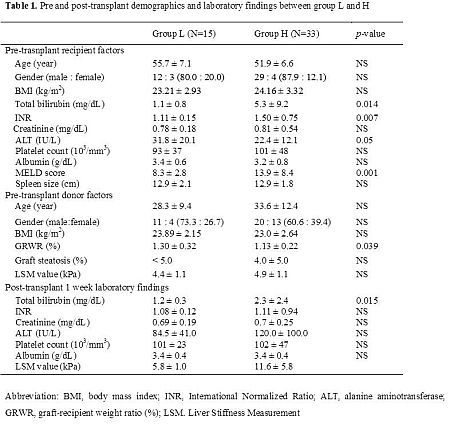Graft Function Measured by Transient Elastography in Living Donor Liver Transplantation: Preliminary Results
Department of Surgery, Yonsei University College of Medicine
Research Institute for Transplantation,
Internal Medicine, Yonsei University College of Medicine, Seoul, Republic of Korea
Meeting: 2013 American Transplant Congress
Abstract number: D1618
Introduction: Liver stiffness (LS) measurement using transient elastography (TE) provide a non-invasive means of assessing liver fibrosis and are correlated to hepatic cholestasis. However, few studies have been conducted to examine the applicability of TE after in living donor liver transplantation (LDLT). In this pilot study, we investigated the correlation between LS values and perioperative clinical and laboratory parameters in LDLT recipients.
Patients and Methods: Forty-eight LDLTs performed between November 2010 and October 2012 were retrospectively reviewed. All donors and recipients underwent TE and abdominal computed tomography (CT) and biochemical tests were performed within 1 month before LDLT and at 1 week after transplantation. Using a cutoff LS value of 7.5 kPa indicative of significant fibrosis, we divided our study population into two groups, Group L (≤7.5 kPa; n=15, 31.3%) and Group H (>7.5 kPa; n=33, 68.8%).
Results: Pre-transplant serum total bilirubin, INR (International Normalized Ratio), and MELD (Model for End-stage Liver Disease) score of recipients were significantly higher in Group H than in Group L. Regarding the pre-transplant characteristics of donors, GRWR (graft-recipient weight ratio) was significantly smaller in Group H (P=0.039). In addition, post-transplant 1 week serum total bilirubin was significantly higher in Group H than in Group L (2.3 mg/dL vs. 1.2 mg/dL, P=0.015), although no biliary complication or hepatic congestion was identified by abdominal CT.

Of the post-transplant 1 week laboratory findings, only total bilirubin was found to be positively correlated to post-transplant 1 week LS values (P=0.044).
Conclusions: This pilot study suggests that a high LS value after LDLT suggests intrahepatic cholestasis and portal hypercirculation of the graft, irrespective of liver fibrosis, outflow obstruction, or biliary obstruction.
To cite this abstract in AMA style:
Lee S, Joo D, Kim S, Kim M, Lee A, Choi G, Choi J, Han K, Kim S. Graft Function Measured by Transient Elastography in Living Donor Liver Transplantation: Preliminary Results [abstract]. Am J Transplant. 2013; 13 (suppl 5). https://atcmeetingabstracts.com/abstract/graft-function-measured-by-transient-elastography-in-living-donor-liver-transplantation-preliminary-results/. Accessed December 8, 2025.« Back to 2013 American Transplant Congress
